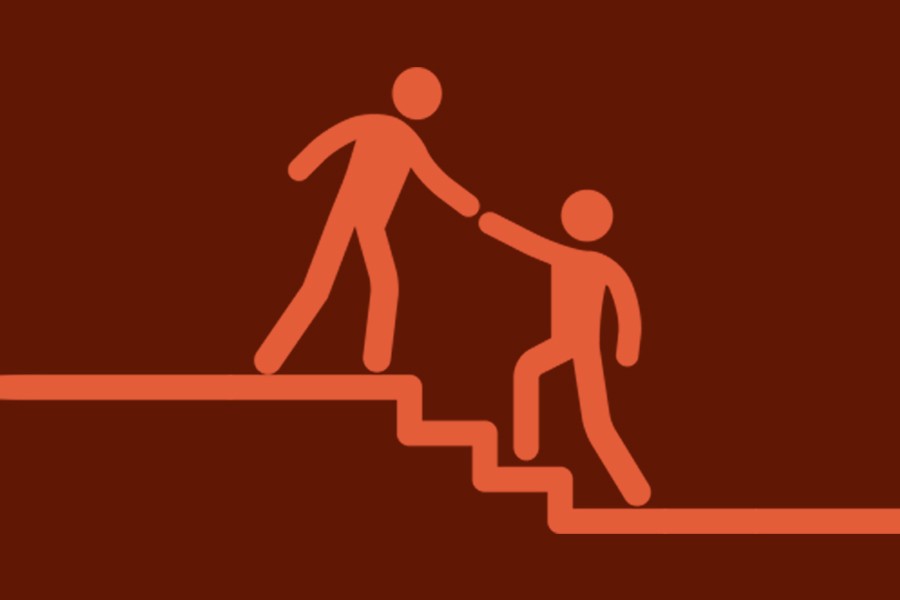Former Finance Minister A M A Muhith didn't recognise the empowerment that organisations such as BRAC and PKSF are believed to have created in lifting people out of the vicious cycle of poverty. According to him these agencies had essentially failed. Government statistics suggest that overall poverty now afflicts roughly a quarter of the country's population. On the surface of it, Mr. Muhith is correct; and then again he is not.
BRAC figures that it has been able to lift the lifestyle of some 19 million out of what it calls ultra poverty. That key word 'ultra' explains why success in poverty alleviation isn't that visible. As agencies work towards self-sufficiency of the ultra poor there are backward linkage issues that are forcing those that move to the 'poor' segment to migrate to the cities thereby increasing the slum areas of the major metropolises.
PKSF has poured massive amounts of money to the cause of empowerment but it too has struggled to create a sustainable backward linkage, especially for goods that are either grown or manufactured in villages. In short, they all lack an Aarong-type of organisation at the other end. To be fair there have been allegations against Aarong of depriving fair prices to farmers and poor manufacturers. The argument is that that increases the cost to the end consumer. However, Aarong prices are no longer the domain for the middle class but rather for the upper middle class. Similar accusation has been levelled against Small and Medium Enterprises Foundation. The fact of the matter is that even as empowerment is working, there is emerging the need for newer skills which are now required for sustainable jobs in the cities.
The government is repeatedly emphasising the need for newer skills even as it urges for labour-intensive newer industries. But it faces the challenge even in the new economic zones that it has created. Investors that are entering these zones aren't essentially seeking labour. What they require are semi-skilled to skilled workforce and the best they can do is to train those trainable.
Slush funds enabling the poor to open up street vending have had some impact but they are dependent on those that are attracted to such vendors. Cattle raising was one of the success areas, especially when the Indian government banned illegal exports of cows during Eid-ul Azha but this year many cattle rearers ended up having to take the animals home as people found the asking price beyond their means. In the midst of this the government plans to import beef to keep prices within consumer grasp, a move that has been opposed by the association representing the cattle rearers. Their argument holds good that there is enough locally produced cattle to meet the beef requirements and that the higher prices are due to higher costs. In their case, as is that with Aarong, is the penchant seeking higher margins on goods.
The closure of over fifty garments industries due to the inability to find money to meet the increased compliance standards has resulted in some six thousand workers being retrenched. Even if they have been paid their dues, these workers will either have to upgrade their skills, learn new ones or fall immediately into the cycle of poverty. They are then classified as poor rather than ultra poor.
BRAC's approach to poverty has changed from economic poverty to focus on social uplift beyond economic poverty. Using the concept of 'The Science of Hope' they are investing in the intangibles such as education, health, self worth, confidence, voice and respect in the community. In other words, a rounded uplift from their present state is what is being eschewed. Unfortunately, there aren't reliable figures that separate the poor and ultra poor and a more coordinated approach is required to reduce this gap and prevent a downslide for the poor.
There's also the dichotomy of the poor vending goods supplied by SMEs (small and medium-sized enterprises) rather than trying to sell their own goods because of the quality aspect. In the aspect of prices not being affixed they are finding it difficult to make ends meet. The government plans to construct quarters for them to be able to leave the slums and have access to clean water and sanitation, but that will take time. When that happens there should be a qualitative change in their living standards. How they will maintain standards depends on how they can find the adequate backward linkage for the goods they manufacture or acquire the newer and finer skills. As more industries lean towards automation and artificial intelligence (AI), the skill sets of labourers will have to change. Whether the BRAC or other non-governmental organisations (NGOs) are looking at this aspect is not known but more and more industries are crying out for these skills.
The best estimates suggest the ultra poor being 12 per cent of the population with another 13 per cent in the poor segment. There has been success in reducing the ultra poor segment but there is always the fear of a slip. The number of the unemployed has doubled in the past four years or so. The numbers entering the job market both in uneducated and educated sector far outnumber the job generation that the country produces. It's the old story of fewer industries being invested in.
The dangers of continuous unemployment are widespread encouraging crime and even begging. A sustained focus on both the ultra poor, somewhat like the loans given to marginal farmers through opening accounts with Tk 10 -- the brainchild of the former governor of the Bangladesh Bank -- can be used to ensure that funds are not spilled.


